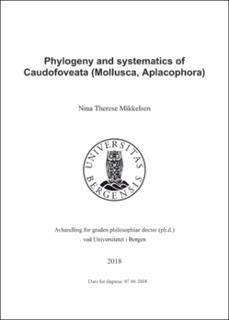| dc.contributor.author | Mikkelsen, Nina Therese | |
| dc.date.accessioned | 2018-06-21T09:24:34Z | |
| dc.date.available | 2018-06-21T09:24:34Z | |
| dc.date.issued | 2018-06-07 | |
| dc.identifier.uri | http://hdl.handle.net/1956/17813 | |
| dc.description.abstract | Caudofoveata is by far the least known group of molluscs. The shell-less, wormshaped caudofoveate molluscs are characterized by a mantle covered in calcareous sclerites, giving them a distinctive, shiny appearance. Caudofoveata consists of 141 recognized species found from intertidal habitats to the deep-sea, where they live burrowing in sediments. Three families are recognized within Caudofoveata; Prochaetodermatidae SalviniPlawen, 1975, Chaetodermatidae Ihering, 1876, and Limifossoridae Salvini-Plawen, 1970. Evolutionary relationships of the group have been debated, yet studies investigating the phylogeny of the group have been lacking. In this thesis, the phylogenetic relationships within and among the families of Caudofoveata are investigated using molecular phylogenetics and analyses of whole mitochondrial genomes. Special emphasis was put on the fauna of the northern Atlantic Ocean, including the description of a new species, and a thorough investigation of one of the most common species in the area. In order to investigate relationships among and within families of Caudofoveata, phylogenetic analyses were performed using six sequenced fragments of selected mitochondrial and nuclear genes from 38 species representing all three recognized families of Caudofoveata with species from worldwide sampling locations. In resulting trees, contrary to traditional views, Prochaetodermatidae is sister to a clade containing the other two currently recognized families, Chaetodermatidae and Limifossoridae. The monophyly of Prochaetodermatidae is highly supported, but Limifossoridae and Chaetodermatidae are not recovered as monophyletic. Most of the caudofoveate genera are also not recovered as monophyletic in our analyses. Thus, results from our molecular data suggest that current classification of the group is in need of revision and indicate different evolutionary scenarios than previous hypotheses based on morphology. Within the family Chaetodermatidae, Chaetoderma nitidulum Lovén, 1844 is a common species of caudofoveate with a wide distribution range in the North Atlantic. It was the first species of aplacophoran mollusc to be described, but its species identity has been debated. Here, the molecular and morphological diversity of specimens of C. nitidulum from a large geographical area and size range was investigated. Analyses of molecular data revealed two distinct genetic lineages in the eastern Atlantic and one clade sister to these in the western Atlantic Ocean. Morphological analyses revealed significant variation that does not reflect the genetic linages. In addition, investigation of molecular markers combined with comparative morphological analyses showed that radula characters used to distinguish the genera Chaetoderma and Falcidens within Chaetodermatidae do not represent apomorphies, but are a result of ontogenetic changes in C. nitidulum. Together Caudofoveata and Solenogastres, the other group of worm-shaped mollusc, constitute the clade Aplacophora. Because many morphological characters of the aplacophoran molluscs have been presumed to be plesiomorphic for Mollusca, Aplacophora has been regarded as early branching within Mollusca. In recent years, Aplacophora has received much attention as part of Aculifera, a clade grouping Caudofoveata and Solenogastres with Polyplacophora (chitons), as sister to the remaining molluscs. In this thesis, mitochondrial genomes of five species of Caudofoveata and one species of Solenogastres were sequenced, in order to shed light on higher-level relationships within Caudofoveata and their placement within Aculifera. Comparison of mitochondrial gene order among different lineages revealed a highly conserved order of protein coding genes, corresponding to the hypothesized ancestral gene order for Mollusca. Unique arrangements of tRNAs were found for the major lineages of Aculifera, as well as for the families of Caudofoveata. Phylogenetic analyses of amino acid sequences for all 13 mitochondrial protein-coding genes recovered Chaetodermatidae, but not Limifossoridae, monophyletic. Aplacophora was recovered as monophyletic and sister to Polyplacophora. | en_US |
| dc.language.iso | eng | eng |
| dc.publisher | The University of Bergen | en_US |
| dc.relation.haspart | Paper I: Mikkelsen, N. T., Todt, C., 2014. Diversity of Caudofoveata (Mollusca) around Iceland and description of Psilodens balduri sp. n. Polish Polar Research 35, 279- 290. The article is available at: <a href="http://hdl.handle.net/1956/17812" target="blank">http://hdl.handle.net/1956/17812</a> | en_US |
| dc.relation.haspart | Paper II: Mikkelsen, N. T., Todt, C., 2018. One or many? Molecular versus morphological diversity in the aplacophoran Chaetoderma nitidulum Lovén, 1844 (Mollusca: Caudofoveata). Journal of Molluscan Studies 84(2), 113–131. Full text not available in BORA due to publisher restrictions. The article is available at: <a href="https://doi.org/10.1093/mollus/eyy009" target="blank">https://doi.org/10.1093/mollus/eyy009</a> | en_US |
| dc.relation.haspart | Paper III: Mikkelsen, N. T., Kocot, K. M., Halanych, K. M., 2018. Mitogenomics reveals phylogenetic relationships of caudofoveate aplacophoran molluscs. Molecular Phylogenetics and Evolution. Full text not available in BORA due to publisher restrictions. The article is available at: <a href="https://doi.org/10.1016/j.ympev.2018.04.031" target="blank">https://doi.org/10.1016/j.ympev.2018.04.031</a> | en_US |
| dc.relation.haspart | Paper IV: Mikkelsen, N. T., Todt, C., Kocot, K. M., Halanych, K. M., Willassen, E. Molecular phylogeny of Caudofoveata (Mollusca) challenges traditional views on relationships. Full text not available in BORA. | en_US |
| dc.title | Phylogeny and systematics of Caudofoveata (Mollusca, Aplacophora) | en_US |
| dc.type | Doctoral thesis | |
| dc.rights.holder | Copyright the Author. All rights reserved | en_US |
| dc.identifier.cristin | 1594820 | |
